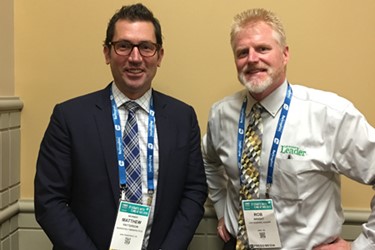What Prepared Matt Patterson To Be CEO Of Audentes Therapeutics
By Rob Wright, Chief Editor, Life Science Leader
Follow Me On Twitter @RfwrightLSL

Before Matt Patterson turned 40-years old, he had the opportunity to work as acting CEO for Amicus Therapeutics, the company for which he was then serving as COO. “John Crowley, the company’s chairman and CEO, was considering alternative careers at the time, so he decided to step down,” Patterson explains. And while being a CEO hadn’t been a driving force for Patterson (now founder and CEO of Audentes Therapeutics and subject of an upcoming feature in Life Science Leader) in his early days, the experience (albeit just five-months as Crowley ended up returning as CEO) clarified for him that not only could he do the job, but that he should do the job. “But even before that there were tremendous lessons learned that helped prepare me to be a CEO,” he says. For example, one lesson was working with a board of directors at Amicus that were largely VCs and learning how to collaborate in a productive manner. Working on additional private financings and figuring out how to navigate those challenges were learned there as well. “On the scientific and clinical side, Amicus had a vision for how the clinical development of its lead program would go, how the regulatory conversation might advance, and I learned a lot when it didn’t go as smoothly as we had hoped,” he notes. On the investor side, Amicus was already publicly traded when Patterson took the CEO reigns, so navigating that community through the ups and downs of clinical development was another valuable lesson. “But before that, learning the process of going public and getting to know people and developing relationships on that side of the business proved extremely important,” he says. From his experience as COO and acting CEO at Amicus, Patterson picked up a reputation for being a straight shooter, which he believes benefitted him enormously when becoming CEO of Audentes. “I’ve always tried to be clear, not just about what’s going great, but the challenges being faced,” he adds.
Patterson learned a lot about partnerships, too, while at Amicus. “We established a partnership that was largely based on a development program, and when that program experienced a setback in the clinic, the partner wanted out, so we had to navigate the financial reality of them no longer paying for half of the development costs along with the loss of potential milestone payments down the road.” Patterson says learning how to explain such an event to investors and staff proved foundational to his development. Around the same time, Amicus also had to reduce staff, which Patterson asserts as being one of the greatest challenges a leader ever faces. “It is never easy to say goodbye to friends and colleagues that you’ve enjoyed working with over the years,” he says.
Henri Termeer — A CEO Worthy Of Emulation
But Patterson has picked up other valuable leadership lessons along his journey. For those who don’t know, the CEO of Audentes actually began his career working in manufacturing for Genzyme, one of the first ever biotechs and led by an executive that went on to become an industry legend — Henri Termeer. “I was a pretty junior guy at the time, so it wasn’t like I interacted with Henri on a regular basis,” he admits. But when he decided to start Audentes, Patterson reached out to Termeer for advice. “We spoke on the phone twice in the early days of building Audentes,” he recalls. “The fact that he would take 30 minutes out of his day, twice, with someone he didn’t know very well, says a lot about his passion for seeing young people, science, and rare disease therapeutics succeed.”
Patterson’s career path included stints at Genzyme, BioMarin, and Amicus, and he says he learned a lot from observing CEOs. “You learn the types of characteristics you want to emulate, as well as those you don’t.” On the internal side of leading an organization, Patterson learned the value of only hiring very smart people and ensuring they have the opportunity to challenge and engage in thoughtful conversation. CEOs he admired did a good job of listening before making a decision. An example of a trait he never found worthy of emulation was someone who was essentially given an update by a subordinate and would then do the equivalent of pounding their fist on the table and then doing the opposite of whatever the subordinate had recommended. “Everyone in the room knew it was a bad idea, but the CEO was going to make a decision and that was that,” he says. “I always think of leadership as this tricky balance between confidence and humility. You need the humility to understand what you do and don’t know, but also the confidence to make decisions.”
